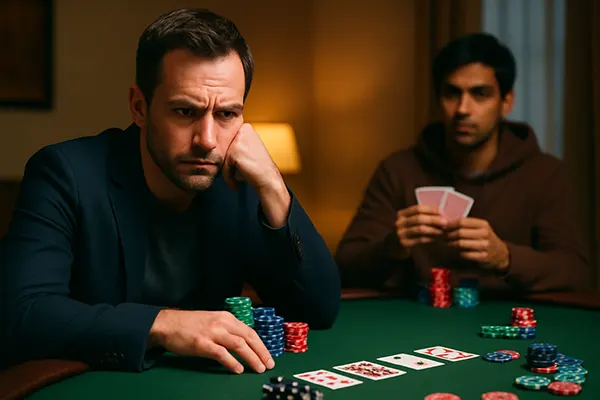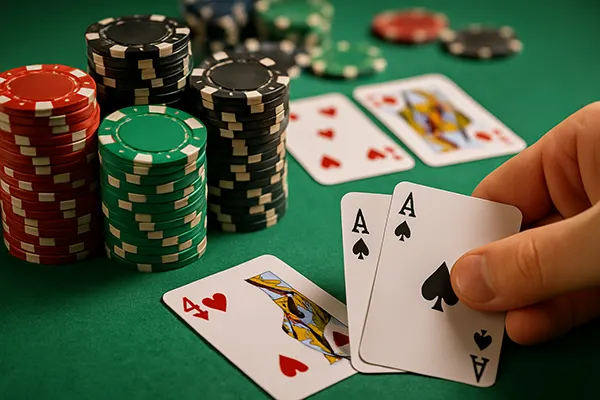
Psychology in Poker: Managing Emotions, Reading Opponents and Avoiding Tilt
Poker is a game of strategy, calculation, and psychology. While mastering betting techniques and card combinations is important, it is often the mental aspect that separates average players from consistent winners. Understanding how to manage your own emotions, read the behaviour of others, and avoid emotional outbursts (tilt) is essential to long-term success at the poker table.
Emotional Control and Mental Discipline
In poker, emotional balance is just as critical as a good hand. Frustration, overconfidence, fear or anger can cloud judgment and lead to impulsive decisions. Players who learn to maintain a calm and rational mindset are far less likely to make costly mistakes under pressure. Mental discipline requires practice and a strong awareness of one’s internal state during the game.
One effective technique is mindfulness: the ability to stay present and observe your feelings without reacting to them immediately. By focusing on the current moment and making each decision based on logic rather than emotion, players can increase their accuracy and reduce unnecessary risks. Regular mental exercises like meditation or breathing techniques can strengthen this ability over time.
Also important is the development of emotional resilience. Poker is inherently a game of variance – even the best players experience losing streaks. Recognising that short-term losses do not define your skills allows for a more stable and objective approach to each session.
Common Triggers of Tilt and How to Neutralise Them
Tilt is a mental state where frustration or disappointment overrides logical thinking, leading to poor decisions. Some common triggers include bad beats, disrespect from opponents, or prolonged periods of losing. Identifying your personal triggers is the first step in learning how to avoid tilt.
To manage tilt, take a short break from the table when you notice your emotions rising. This could be a simple walk, stretching, or stepping away to reset your focus. It’s also useful to establish internal rules before playing – such as a maximum loss limit or a clear exit strategy if you begin feeling overwhelmed.
Regular self-reflection is another powerful tool. After each session, note the moments when emotions interfered with your play. Over time, you’ll begin to spot patterns and develop stronger resistance to these triggers, enabling a more composed and effective presence at the table.
Analysing Behaviour and Non-Verbal Cues
While physical tells are less relevant in online poker, in live games, non-verbal communication remains a vital aspect of strategy. Skilled players use subtle cues to gauge the strength or weakness of an opponent’s hand. These might include facial expressions, body posture, eye movement, or betting patterns.
One key to successful observation is consistency. Watch how an opponent behaves during both strong and weak hands. Changes in their usual behaviour may signal deception or discomfort. For example, a player who usually talks a lot but suddenly goes silent may be nervous or bluffing.
However, reading tells is not about relying on stereotypes. Each player is unique, and context is crucial. The best results come from developing a mental profile of regular opponents and adjusting your interpretations as the game evolves. Patience and attention to detail are the most valuable tools in this area.
The Role of Table Image in Psychological Strategy
Table image refers to how others perceive your playing style. Whether you appear loose, tight, aggressive or passive, your image affects how opponents react to your bets. Controlling and manipulating this image is a sophisticated way to gain an edge during play.
If you are seen as a tight player, occasional bluffs are more likely to succeed because others assume you only bet strong hands. Conversely, if you’re known for playing loosely, a strong bet might not be taken seriously. Adjusting your behaviour deliberately allows you to create confusion and extract value when the timing is right.
Understanding how others interpret your actions also helps you anticipate their reactions. This dynamic interplay of perception and misdirection forms the core of psychological warfare in poker, making it not just a game of cards, but a game of minds.

Building a Long-Term Psychological Strategy
Short-term tactics may win individual hands, but a long-term psychological approach is key to sustained success. This involves ongoing self-awareness, a structured improvement plan, and a focus on mental fitness. Poker demands constant learning and adaptation – not only to trends and opponents, but to your own evolving mindset.
Keeping a poker journal can support this development. Record sessions, emotional states, mistakes and wins. This information forms a personal blueprint of your psychological landscape and helps pinpoint areas to improve. Just like reviewing hand histories, analysing your own mental game offers deep insights.
Finally, connecting with other players or working with a coach can accelerate progress. Discussing psychological strategies, tilt management, and observation skills with peers adds perspective and encourages accountability. In a game where small edges make a big difference, investing in mental performance is just as important as technical skill.
Balancing Competitiveness with Mental Health
Many players fall into the trap of overtraining or obsessing over results. While ambition is important, maintaining mental health should never be sacrificed for poker success. Burnout, fatigue, and emotional instability are common when players neglect rest and personal balance.
Establish clear boundaries: schedule breaks, pursue other interests, and avoid defining your self-worth by poker outcomes. The game should be challenging but enjoyable – not a source of chronic stress or frustration. Remember, optimal performance comes from a place of balance and well-being.
Developing a supportive routine outside the game – including sleep, nutrition, exercise, and social connection – strengthens emotional regulation and overall mental clarity. A healthy lifestyle reinforces resilience at the table and supports consistent, strategic decision-making over time.



